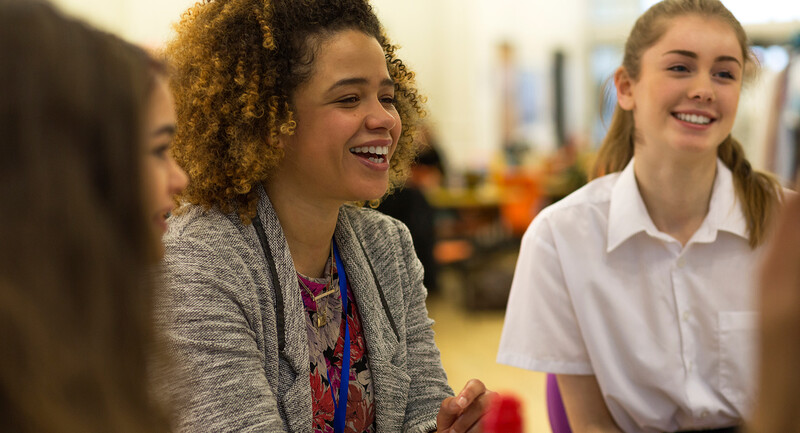One student passed out in the middle of a U.S. history presentation. "I watched her crumble and had to run and catch her," recalls Karen Grace, who teaches at Roosevelt High School in Seattle, Washington. Another student had a "full-on panic attack" during class.
The anxiety in the air these days is so palpable you can almost feel it, Grace says. "I walked more panicked students to the health center this year than in all my previous 15 years of teaching.
"Students are just coming unglued."
A Double Whammy
Like Grace, most educators attest that student anxiety is on the rise. "Anxiety disorders are the most common psychiatric illnesses in children," says Golda Ginsburg, child psychologist and professor at the University of Connecticut. According to the National Institute of Mental Health, 25 percent of children ages 13–18 have a diagnosable anxiety disorder. Ginsburg says that number may be even higher, as anxiety is often "underdiagnosed and undertreated."
The academic effects of anxiety can be crippling, notes Jessica Minahan, behavior analyst and coauthor of The Behavior Code. When anxiety increases, "working memory" skills plummet. Students might study for a test but suddenly be unable to access that information in their short-term memory. They might even blank on basic math knowledge.
When students are unaware of how anxiety impacts their brain, the message they take away is that they need to study harder. "So the next test they stay up later trying to memorize everything," says Minahan. Then they come in exhausted and under more pressure—which makes the test anxiety worse. "We can lose 13–20 IQ points in a moment of anxiety."
It's a double whammy, she says—anxiety affects both working memory and efficiency. An anxious child may still get an A on an assignment, but the mental block could result in it taking her three extra hours to complete the work.
Look for Red Flags, "Don't Diagnose"
"The first thing to do if you're worried about a student is to refer them to the student support team," notes Minahan. "Those mental health professionals will help you decide if [the student] needs testing and also exactly what to communicate with parents. From there, that team will help you determine next steps."
Adriana Salcedo, a social worker at E.L. Haynes High School in Washington, D.C., urges teachers to stay updated on IEP plans and behavior goals for students with the highest needs. For those with less severe anxiety, setting expectations and maintaining consistency can help. And, like Minahan suggests, reach out if you observe a change in a student's behavior.
"We don't need teachers to diagnose students," cautions Ginsburg. "We want them to know what the red flags are and some basic, helpful anxiety-reduction skills." The symptoms, as she describes, are all over the map.
1. Somatic complaints: Anxious students may complain of headaches, stomachaches, nausea, heart palpitations, light-headedness, or other physical ailments (without having an underlying medical cause). They may also routinely ask to go to the bathroom or to the nurse's office, explains Ginsburg.
2. Distorted cognition: Students with anxiety can become preoccupied with failure or perfectionism and "might email the teacher constantly or want frequent reassurance about how they're doing," she continues. As Minahan explains, they tend to default to "all-or-nothing" thinking ("I always screw up" or "You never call on me") or "catastrophic" thinking (a single mistake could send them into a panic that they won't get into college).
3. Behavior: Avoidance is the most observable behavior among anxious kids, states Ginsburg. They might refuse to take a test or avoid raising their hand to answer a question. Or, they might put their head on their desk and completely shut down. "We're neurologically programmed to avoid something stressful," adds Minahan. When we are in a heightened state of anxiety, the limbic system goes into overdrive and our brain is basically saying "don't think about it, just get out of here."
When a student refuses to do work, the behavior may be perceived as "noncompliant" or "manipulative." But Minahan sees it as a skill deficit.
Tips to Avoid the Rabbit Hole
When we tell anxious kids to "calm down," we're assuming they have the skills to do so. However, there are several social-emotional skills that could be underdeveloped in children with anxiety: self-regulation, negative thought stopping, perspective taking, executive functioning, and flexible thinking. "Those five skills go down like an elevator when anxiety goes up," says Minahan.
The good news is that when teachers help build these skills, "the challenging behavior, the avoidance, and the acting out will inherently go down."
✓ Tackle Transitions
An anxiety-provoking challenge for some teenagers is just making the transition from a "preferred" to "nonpreferred" activity, explains Minahan. Heading from the hallways where "every conversation is life or death" into a subject like math can immediately send students down a rabbit hole of worrying thoughts. This can be exacerbated when the teacher starts with a "do-now" or structured small task, says Minahan. Teachers can help students "reset" by starting class with meditation, showing a YouTube clip on a review concept, or leading a fun two-minute word game to practice vocabulary.
Similarly, Minahan advises against collecting homework or asking students to write down assignments for the night in the first 10 minutes of class. "Homework is one of those anxiety-provoking words," she emphasizes. "You can lose time on learning for some kids and start them off anxious."
Anxiety manifests during downtime, too—in the first or last few minutes of class, when switching between activities, or during cleanup. Minahan recommends "transition sponges"—"little activities that absorb downtime and prevent kids from getting too stressed and dysregulated." For example, she says, assign a routine physical task: "Can you bring this across the hall to another teacher?" or "Can you wipe off the white board?" Basically, "keep them very busy."
✓ Offer "Cognitive Distractions"
Providing frequent breaks is a common accommodation for students with anxiety, particularly test anxiety. But unstructured breaks, such as "telling kids to get a drink of water and come back," gives them time to "ruminate in their thoughts." Minahan recalls how an anxious 7th grader, who was chronically picking the tops of her fingers and scratching her arms, was given breaks to draw at her desk. But what the researcher noticed was that the breaks didn't stop the picking and scratching. And, Minahan adds, the girl had a difficult time reengaging in her work—a hallmark indication of whether the break was helpful.
So her teachers tried something different: they had the girl work on a few pieces of Sudoku. The challenging puzzles kept her distracted (no picking or scratching) and when they were completed, "she got right back to work." Other teachers, says Minahan, have tried similar "cognitive distractions" like "hidden pictures or Mad Libs" or asked anxious kids to "think of the lyrics of their favorite song," "remember the birthdays of their family members," or "recall the first 10 lines of a Star Wars movie."
✓ Make It Manageable
When teens get overwhelmed by their workload, "we have to be the logic for them," says Salcedo, and "break it down so they feel like they can be successful." That's exactly what E.L. Haynes recently did with volunteer hours. High school students in D.C. Public Schools are required to complete 100 hours of community service by graduation. "What they ended up doing was waiting until the last three months of their senior year, and now they're stressing about that on top of getting into college and figuring out prom." So the school changed its policy, requiring students to complete 25 hours each year. It shifted their mindset from "I can't deal with this—I'll think about it later" to "25 hours, that's easy!"
✓ Apply a Label
When anxiety takes over, "the simple act of applying language to [our fears] helps reengage the thinking parts of our brains," says Grace. Before students take a test, she asks them to write down their worries, "do a cathartic crumple" of the paper, and then throw it in the trash. It's a symbolic gesture, she admits, but it teaches the act of labeling anxiety: "I'm going to fail this test. I'm never going to get into the school of my dreams. My life will be ruined." Once students get to about the third statement, they "realize that's not an actual chain of events that's going to come from this one experience."
✓ Teach the Physical Signs
Teachers can also help students notice what it feels like when their anxiety is escalating, says Minahan. Younger students can use tools like an "emotional thermometer" or do "body checks." Teachers can pull aside older students and ask, "Is your heart racing right now? Are you feeling warm? Are your thoughts racing?" Once they become aware of where they are on a scale of 0–10, they can rely on strategies to stay regulated.
✓ Help Them Initiate
When it's time to start a task, "does a student ask to go to the bathroom, talk to the kid next to her, stare off into space, get a pencil 20 million times, or all of a sudden have a stomachache and need to go to the nurse?" Avoidance is a "brain-based reaction to stress," explains Minahan. Essentially, that "flight response" is kicking in.
Teachers can provide accommodations by intervening "before the negative thinking starts." Help students start their work or try previewing content so they know what to anticipate. "Pull them aside on a Monday and say, 'This is the graphic organizer that you're going to use on Tuesday,' and start it with them," Minahan advises. Or show them the math problems that you'll be tackling and work on the first three together.
The same goes for homework. "If you have time, help kids start their homework in class and send them home to finish." If a homework assignment involves writing, Minahan teaches kids to "write one sentence but to stop mid-word, mid-sentence on the second one." So, when they get home, "it's very unlikely that they can't initiate finishing a word."
Julia Plunkett, a 5th grade teacher at Hardy Elementary School in Arlington, Massachusetts, uses laminated cards to reinforce self-advocacy skills (i.e., how to move forward if the directions are unclear) and math reference sheets (drawn from the sample problem reviewed in class). For writing tasks, Plunkett says "premade sentence starters or templates are great tools to initiate, too."
✓ Check in Routinely
Predictability is one of the most important things for students with anxiety, agree Minahan and Ginsburg. They might resort to seeking negative attention because they know they will get a reaction. "If a kid in class starts tapping his pencil loudly on the table, most teachers within two to four seconds will say his name. However, if he's sitting there quietly working, he has no way of predicting when the teacher is going to come check on him," says Minahan. One way to prevent this is to make a plan for providing positive contact throughout the class period.
Meet anxious students at the door and say you'll check in with them in five minutes, Minahan suggests. Set a timer or an alarm on your phone so you don't forget. Then, once you check in, tell them that you will be back in 10 minutes and set the timer again. Or write "10:15" on the top of their papers and then walk away. When students know you'll be back, "they won't resort to other kinds of behavior."
✓ Give Private Praise
Finally, avoid giving students with anxiety "public praise," which can derail their efforts. If you say, "Johnny, hold that up, you nailed that!" a child with academic performance anxiety could think, "I'll never live up to that again." Receiving private praise is typically more comfortable, says Minahan. However, if you offer private praise and still get a discontented response, such as a negative or rejecting comment, or if the student covers his work with his hands, it could be due to illogical thinking: "When you're whispering [to an anxious student], he may think everyone can hear." An alternative is to ask in the beginning of the year, "When I'm proud of you, how can I let you know?" Suggest options like writing the student a positive note or having him check in at the end of the day, but let him set the expectations.
A Sign of the Times
At Roosevelt High School, two student suicides and noticeably increasing stress and anxiety were a wake-up call. As a response, the staff implemented "Rider Time" (named after the school's mascot)—a 20-minute break after second period for students to catch up on work or just relax. Once a week, teachers use the break to lead a mindfulness curriculum, guiding students in calming techniques such as breathing exercises and journaling.
Administrators also lengthened time between bells so students feel less frenetic and rushed, and they worked with parents to discourage students from overloading on AP courses. Relieving pressure at the highly competitive school provides a much-needed pause, says Grace.
"Anxiety is manifested in the classroom," notes Ginsburg, which puts teachers on the front line. She urges teachers to educate themselves about the signs of anxiety and find appropriate resources. "Take it seriously, and if you can't provide students with help, connect with someone in the school who can." Although students with anxiety may not demand teacher attention like classmates with more disruptive behavioral challenges, "they are just as deserving and needy."









